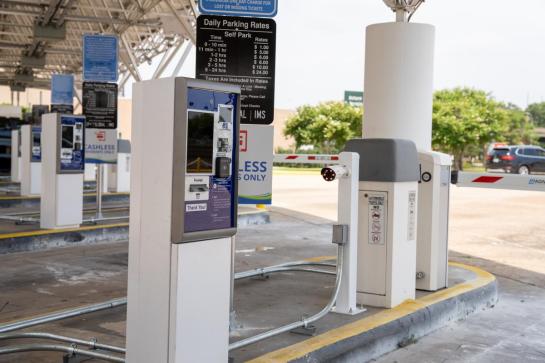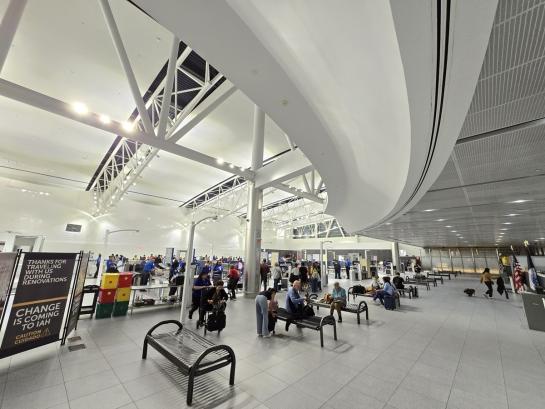As record numbers of passengers passed through Houston’s airports this summer, thoughtful adaptations and new strategies paved the way for a more seamless travel experience.
This summer, Houston Airports navigated an unprecedented surge in passenger traffic while embarking on a series of transformative initiatives aimed at enhancing the travel experience at George Bush Intercontinental Airport (IAH) and William P. Hobby Airport (HOU).
The summer of 2024 was one for the history books, with Houston Airports welcoming a record 19 million passengers from Memorial Day to Labor Day, a 7% increase over 2023. This surge reflects the city's growing appeal as a business and leisure destination, coupled with new airlines and flight options at Bush and Hobby airports.
May 23 welcomed the start of the summer flight schedule at Bush Airport with more than 60 new daily flights in and out of Houston added to the schedule.
More flights and new destinations drove up passenger totals, a positive sign for Houston's economy.
RELATED | Allegiant launches seasonal nonstop flights from Houston to Knoxville
RELATED | Houston Airports celebrates inaugural flight of Avelo Airlines
This surge in travelers was met with proactive measures, such as the opening of 600 new parking spaces at IAH’s Terminal C/D/E Garage, providing much-needed capacity during peak periods. Yet, it wasn’t just about managing numbers; it was about improving the passenger experience every step of the way.
This summer, Houston Airports announced $30 million in major restroom renovations coming soon to Bush and Hobby airports. CLEAR, an official TSA PreCheck enrollment provider, expanded enrollment options to Bush and Hobby airports as a convenient option for passengers looking to enroll of renew TSA PreCheck.
The airport system also began rolling out its cashless parking system. The technology is now in service at Hobby Airport’s Red and Blue Garages and ecopark 2 at Bush Airport. The new system utilizes License Plate Recognition (LPR) technology, which expedites entry and exit for vehicles with parking reservations. Additionally, near-Field Communication (NFC) capabilities enable contactless payment through digital wallets such as Apple Pay and Google Pay, further streamlining the payment process. The project will continue throughout 2024 and 2025, with all parking facilities transitioned to cashless payment by the end of May 2025.

"We knew that with more people, more flights and ongoing construction, this summer would test our systems and our ability to adapt," said Kelly Woodward, Chief Operating Officer for Houston Airports. "Our focus was on finding practical, empathetic solutions that would keep our passengers moving smoothly through our airports."
One of the key initiatives was the implementation of the Active Loading policy at IAH, which streamlined traffic flow and reduced congestion at the airport’s curbsides. This policy was critical during the July 4th holiday, when over 1.9 million passengers passed through Houston’s airports. Despite the surge, traffic backups were minimized, thanks to the deployment of additional Landside Agents and law enforcement officers.
“We have greatly improved traffic backups during off-peak hours,” said Bobby Miller, Senior Division Manager, Airport Operations for Houston Airports. “This policy shift allows us to deliver a world-class experience by prohibiting traffic from building up simply because vehicles are parked and waiting for passengers along the curb. While the policy may seem rigid, the policy’s efficiency and consideration for other passengers allows us to deliver ‘Houston Friendly’ hospitality, but quickly moving vehicles along so others may pull up to the curb.”
The summer was not without its challenges. In July, Hurricane Beryl forced Houston Airports to pause operations for several hours as airport workers assessed damages and initiated emergency repairs after the Category 1 storm whipped across Houston. Houston Airports is responsible for 190,000 jobs at Bush, Hobby and Ellington airports. Many of those employees were impacted by the hurricane.
Aviation Director Jim Szczesniak asked passengers to extend patience and understanding as the airports experienced extended TSA and ticketing lines, limited concessions, amenities and essential services in the immediate days after Hurricane Beryl.
Days after Beryl, a global IT outage temporarily disrupted airline operations, but the response of Houston Airports was swift and customer-focused. The organization deployed extra staff to assist passengers and even brought in therapy dogs to ease tensions, a move that turned a stressful situation into a moment of shared community.
In addition to managing day-to-day operations, Houston Airports continued to make significant strides in its long-term redevelopment plans. This summer, Houston Airports offered a sneak peek of the world-class experience to come.
The opening of a new TSA Recheck area at IAH marked the first phase of a broader effort to centralize security checkpoints, enhancing both efficiency and security for international travelers. As construction progresses toward the completion of the new International Central Processor in 2025, passengers are already seeing the benefits of these upgrades.

“The opening of the new TSA Recheck serves as a symbol of the significant progress we continue to make as Houston Airports prepares for the highly anticipated opening of our new, state-of-the-art international terminal,” said Woodward. “International passengers arriving in Houston are among the first to get a closer look of the new International Central Processor, which I guarantee will wow airport guests when it opens next year.”
This summer, Houston Airports moved forward with its phased transition of the dining experience at Hobby Airport. At Bush Airport, Houston Supply Co. – a news and convenience store – opened between Terminals C and D.
The lessons learned this summer have not only informed immediate improvements but also shaped future strategies. The surge in passenger numbers, while challenging, has underscored the importance of ongoing infrastructure development, proactive communication and a commitment to customer service. As Houston Airports looks ahead, the organization remains focused on its mission to deliver a world-class airport experience.
"In every challenge, there was an opportunity to learn and improve," said Woodward. "We’re entering the fall season more resilient, more prepared and more committed than ever to providing our passengers with the best possible user-friendly experience."